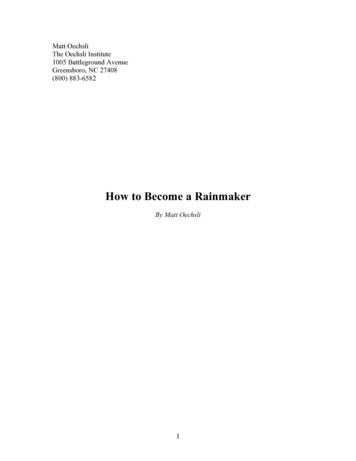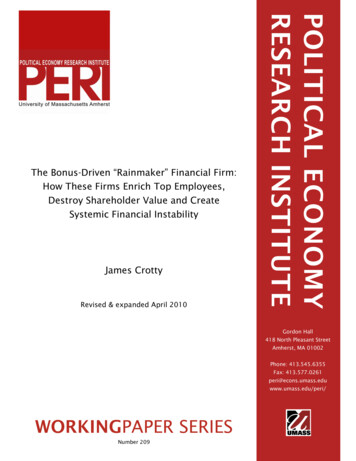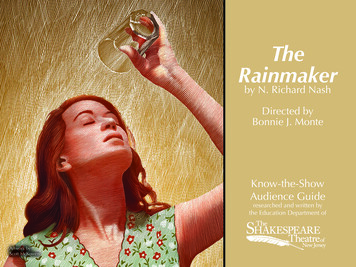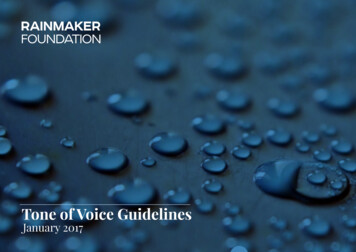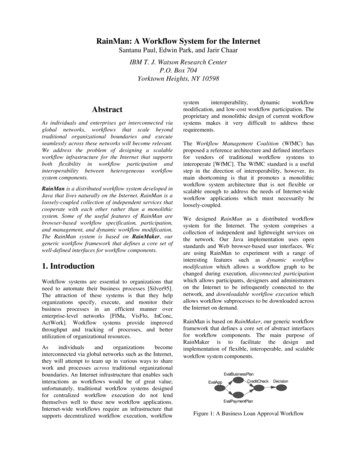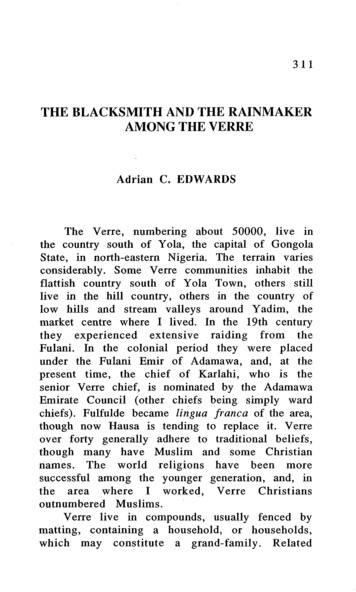
Transcription
311THE BLACKSMITH AND THE RAINMAKERAMONG THE VERREAdrian C. EDWARDSTheVerre,numberingabout 50000, live inthe country south of Yola, the capital of GongolaState,innorth-easternNigeria. The terrainvariesconsiderably.SomeVerre communities inhabit theflattishcountrysouthof Yola Town,othersstilllive in the hi11 country,othersin thecountryoflowhillsand Stream valleysaroundYadim,themarket centrewhere1 ingfromtheFulani. In thecolonialperiodthey wereplacedundertheFulaniEmirof Adamawa, and, at thepresenttime,thechiefof Karlahi, Who is thesenior Verre chief, is nominated by the AdamawaEmirateCouncil(otherchiefsbeing simply wardchiefs).Fulfulde became Zingua franca of the area,though now Hausa is tending toreplaceit. thoughmanyhaveMuslimand ccessfulamongtheyounger generation,and,intheareawhere1 worked,VerreChristiansoutnumberedMuslims.Verre live in compounds, usually fenced bymatting,containinghousehold,aorhouseholds,which may constitutegrand-family.aRelated
312compounds may cluster. close together, and environmentalfactorsmay lead to a number ofcsumpounds beingsufficientlyclosetsgether tohave the appearance of a village, even though theVerre are not really a village society in the sensein which the Pgbo or Y o are. Local grsups are forsome purposes (tax-payments and the work of theChristian churches) seen as more importantthankin groups, so English-speaking Verre speak oftheip "villages" or tltswns".Verrekinshiphas to be understood as theresult of Verre marriage. There were two kinds ofwhich t of a household cornposed ofhusband and wife, whsse children would belsng tothe wife's gromp, and the second marriage bywhich rights over the children were transferred tsthe husband's grsup.The basic kin group is the W Q O m , a three tofour generatiow group, whichperceivedisasprimarilypatrilineal,even thoughbecauseofmarriage rnles some of the nembers may bernothers.Abovethelinked to it through theirw O O m. is the g b a a r ewhich English-sgeakingpeople will cal1"clan".Thisis no4 a very large unit.Oneexcellentinformantestimatedhaving some twenty adult male .of the g b a a r e regardeachotheras kin, genealogicaltiesare nst traceableusuallybeyond thew oom , and the gbaare is not a land-holding unit. Ptbas a head, the b a n a g b a a r e , who is an eldergrimarilyconcernedwith ritualmatters.The other clan functionaries are the t o z , thepriestresponsiblefor the main agriculturalrituals,
313andthe ban a le u z e , the "director of theboys"circumcision rite. In the principle, the banagbaareandthetoz should be differentpeople,butinpractise they maybe the same. A woman can be atoz or a banazeu'ze, and can be anassistant to abanagbaare.The edby theemirateandtheis the s a a ' a zcolonial,orpost-colonial,state(rainmaker).Thereis one chief rainmaker for al1Verre country, Who lives at Ragin, well in to theright (coming from Yola) of the Yola-Fufore road.TherearealsolesserrainmakersatBaiandBoi,Who seem to acknowledge the greater authority ofthe Ragin rainmaker.is concerned with the mythicalAsthispapercontraposition of therainmakerandtheblackSmith, 1 had better Say tedthefinequality of Verre smithing, and thereareanumberof items of Verrebronzework Nigerianinis evidence that Verre metalworkmuseums.Therewas y.At turalistsinVerrecountry(uptothesixties,therewas ablacksmithcommunityMay0at Senitheinsouthern end of Verre country) and produce workfor farming and domestic use,suchasaxes,hoes,needlesfor sewing sacks, rings and also swords fordisplay, bought by both Verre and Fulani.1 heard the myth of the conflict between theblacksmithandtheremainderinmorethanone
314version. Here is the version given me byThe blacksmith went t(rainmaker) met him,saidthather) is greater than him (blaeksmith).The blacksmith said th t it is he (blacksmith)who is greater than him (rainmaker). That is whythey became rivals.ainmakerstopped makingpain for one year. Tboth the rainmdcer andtheblacksmithwerehungry,then the next yearthe blacksmithbroughtfire.Therainmakerrainput out the fire. Then the blacksmith left srnithhgthirngs, then they e r ehungry that year again,two years. Thentheycametogether, theysaidnow they knew they were equal. That is why, ifthe blacksmithbringsfiire, the rain does notquench it,until he finishes plis work.The rainm&er cornes to the forge, then meetsthe bllacksmith forging hoes. Then he chooses ahoe, gives it to the rainm er, says let him f a m .Then they hold hmds, that is how they are equal".Hsw do we "cr&" this myth? 1s it apoliticalmyth about the balance of power in Verne society,is it a cosmicmythabout fire and water asopposing principles,isit a yth which justifies aritual, or is it sipnply a "just- Story" aboutdiscoveringequalitythrougha quarrel ?None of these interpretatisns seem very satisfactory. The saa'aaz is a para-Vene figure and thereis no singlepan-Verreblacksmithfigure,nor dothe blacksrnithsseemto havehadpoliticalfunctions, nor are they surrounded by much ritual.
315Theblacksmiths'feastin May orthereaboutsisessentiallyanoccasionof sociability, and " in speaking of it. The only ritualelementswhich specifically mark theblacksmithidentityareataboo against anybody exceptablacksmitheating food which has been cooked in the smithy,theburialof blacksmithsseparatelyfromotherpeople, and the t u u k s e i . The t u u k s e i is an apparition which lookslikeapig. Anybody Who looksat itdie by snakebite. It is intented to keep peoplefrom lookingatblacksmithswhen they aredoingtheir own work. 1 am not myself quite sure whatthismeans,sinceblacksmithsnowadaysworkquite openly. It might be areferencetothe beliefin magic needlesforged by sorcerers. In any case,the t u u k s e i beundertakenbywizards or witches, and does not seem toindicatesome hs.The myth has, certainly, a cosmic dimension. 1remember,oneevening,Sitting in compoundawhilelighteningwas playingbesideclouds,andbeing told that the story of the blacksmith and therainmaker (of whichtheappearanceof theskyhad reminded my hosts)showedthat water wasmore importantthanfire.Thereareothercosmicmyths among the Verre. For instance, 1 have beentold that there are two suns, which take it in turntorise,shine,and set. When a Sun sets, it turnsintoagoat and runsacrosscountry to thepointwhere it will rise again. On one occasion,amancaughtaSun-goat and shut itupwith his own
goats. Confusionfollowed,since the snn did notrisewhenewpected. However,noteverybodystory, and it di not seem partibelievedthiscularly important to the Verre. The story o f theblacksmith and the rainrnSeemS"open Up"Verrecultureand societthe way that storiesabout sun-goats do nome of the Verrefolktales (seuseui) daim 0 giveexplanationsofcustoms, e.g. "and that is why it is not good ts livealone", but the story of blacksmith and rainmaleerseems to be given more weight.Thefollowingex ct frsm a text (SamuelCholli, 23 April 1) givesbeliefsaboutrs. "The rainr is the person they sayain in the season.r Theperson theysay he is the a 'az,a he has al1 the customs in hishand, from the castoms of the f o ri andtheb a n a l e m e , from water pool (pox, measles, al1 punishments, theyareal1 inrainmaker'shan anddifferentdiseases anddifferent food. Rainm&er, eaeh rainy season, theycollect rnoney for him, they bring him a blackgoatm d a m m , that is, they put the black goat in thecustomary place, then rain cornes in the rainyseason, but if they do not give him anything, Paindoes not Ml. Other people, they beg him that theymay grow a great deall o f corn. Then, when theyhaveharvestedthecorn, theybringhim a manfrom their relatives. Then he agrees; if (this is) not(done), that man who received(theharvest),hewill die himself.If the rainmaker is bringingrain,he entersintohisinnerroom without a door. Then he lieshisheadwitha decorateddown, he covers
317calabash.Thensomething comesoutinhisroomlikemist, then it turns into water, it would spreaddidnottakehisanywhereintheworld if hecalabashoff.Theraindoesnot (maa'azeu ulleus), says "Let the people get corn".Thepeople, they get ashe has said, one year theyget millet one year they get guinea corn. Then hesays to the people of every village with a toz in it,every year if they want something, let him tell thetori, then they send him (a gift), if they do notsend, rain will notfall."Thistextpresentstherainmakerasacontroller of theforcesof nature,andalsoas afigure Who brings has powerovertherainsandthewinds, he can cause diseases, indeedthere is a certain correlation between illness and agood harvest. At the same time, he has links withthe various tori and the circumcision officials, andthesacredpools. Hispowersareanalogoustothose of wizards, even though the taking of ratherthan, as with ordinary wizards anwitches,simplyto steal the prosperityfronotherin ordertohavebiggerafarmpeople'sfarmsoneself.While it wouldbe possible to sketch out VerrecultureandSociety withtherainmakerasthecentralfigure, it should be said that in practice thesaa'az does not seem to.haveconcernedhimselfeven in the past withal1 aspects of Verre life, e.g.he doesnotseemtohavebeenconcernedwithwarfare or thesettlementof disputes, and at the
318present time,whilea relationsikipbetweencircumcision and "wetness" is recognised the aa'ktzdoes not seem ts exercise any particulas authorityover circumcision ceremonies.From where does therainmakerget hispower ? The present (at time of fieldwork) saa'azis the fourth rahmffice, the first onehaving come froata country.Stilltoday, the songs which accompany dances atsacrifices for rainaresung in Bata, because "thegods will nothearVerrelanguage".If we askabout the mystical,ratherthan thehistorieal,origin of the rainmpower, different answersistimsfit minmaking intoby saying that the rainmakerp a y s to God, but 9 have heard one Christian sagrthe saa 'QZ has power by witchcraft, a not unreasonable statement given the beliefsaboutthetaking of humm life.(from S m u e l Cholli) which has beens of the sa 'az "pra-ying to his god",the word maa'oz being used for "god". Christianinformants tend to distinguish between theskpngular rnaa*az which they consider to be l&e Ulla(sun), a word applicable ts the Biblical God, andthe mai , a plural f o m wkich refers to spirits living%t was argged thatthetwointhemountains.words are sirnilar, but do not refer to beings of thesame class.However, rom what I have been toldof the agriculturalrites, and the ceremonial use ofthe g ada Z i category of plants, it would seem thatthesingularnz a a ' a z can refer to particularindividuals of the mai group (l&e "gods" and Wod"in English), and that the saa'az wastraditionally
319seen as an intercessor with a specific spirit of thiscategory.Therainmaker,then,is a person Whoperformsspecificactswithregard to aparticularspirit. But also, to acertainextent,andthisiscertainly the case with the rainmaker's imageinthismyth,herepresentsvaluesof "wetness" fortheVerre,and it is usefultonote some of thesevalues uldbe heldafterthe beginning ofthe rainy season, but give varying reasons forthis.The reasons 1 noted were : if it isheld in the hotseasonjustbefore the rains,theboys willsuffer.New leaves will be needed to act as bandages. Itwill be easier tobrewbeer when rain hasfallen.Circumcisionshouldnot be held beforetheyu 2plant has come up (the yal plantisincluded withthe gadali group of plants). When 1 askedwhy thenewly circumcised boys, Who have to stay in bushaftertheriteof circumcision, Wear leaves, 1 wastold, "They Wear leavesbecausetheirbodiesarehot, they are feeling pain". Some, at least, of theindigenousmedicaltreatmentsseem tobebasedon the idea that leaves whichhavebeensoaked inwater will have a cooling effect - 1 have seen thistreatment applied to snakebite victims. ss caused by heat and needing to be treatedby cool or wet substances.The duur maam (pool of water, plural d u u t inz a a m ) has already been mentioned. It is apool ofwater(thoughevena dried-uppoolmay becountedasa duur nzaanz), asdistinctfroma
320running stream) which .may belong to a g b a a r e("clm"), or to illn individual, in which case it maybe inherited by a son or sister's son. Duuti tnaammay havedistinctivecharacteristics,one may besupposed to give riches, one may be associatedwith wizards, one may have water that will neverboil, to one boys prepaping for circumcision will ben and washed.m) is supposedave a deungs (al Qeungi), thatcornes out in the fsm of a sn&e or an old man.Two services that the elleur maam is believed togive are its use in war time and its value fordivination. One of mgr notes reads, "Owner of du urm a a m before wax will go to duur maam by night.When ready to go ts war, he will spriralkle it frornthe pool on the people, so they get strong for war.If they (are) injured, if not so seriously, when theyt&e man back to duur rnaam, he will not die - willrecover in two days."ith regard t divination,the O o n e r l(either'an individual owner or the a n a [clan a head]) r will go by night to t a k tothe duur maam, and the deupzgs may appear tohim. In some circumstances, the d e u n g s maydemand a human Me, which m es him analogousto a wizard.If rain does not fal19 does it necessasilgr meanthat the saa'az is at fault ? h 19 7, the sains camelater than usual, and this was ascribed to thesaa'az being m g r y that, while people had paid thegovernment dev opment levy,theyhad paidkindof explmation fornothing to him. ut thisdrought is not the only one. Certain wornen arerainfallbelieved to have the power to checkbecause of the rainbows in their stomachs. These
321womenmaybeordinarywomen,womenorholding ritualoffices, such as tooz, or assistant tothe banagbaare. A textStates : "As to the peopleWho wsintheirstomachs.Theserainbows,theyarelikemany snakesintheirstomachs,preventingthemfromSitting comfortably. Any person Who hasrainbowsin herstomachisunhappy, because these rainbowsareformedintheplaceforgivingbirthto achild.Thus, in the dry season, these rainbows do not goout, because thereisno placeforwashing them.Then, if rain falls, they are happy because the skyis darkening. Then, when the rain begins to fa11 onthe mountain, they go there, they go to wash themin the rain which isfalling.They pour them out,goingstraightdown,(itis)not good tosee,onlywizards and witches thenseeit, if you are not awizard or witchyoudonotsee them.""Whentheyhavebroughtthemout,theywash them,somered,some blue. Thenthedirtwhichtheywash,itgoesup likesmokegoingstraightup,wherethatrain is falling. If they in,becausethesmokefromtheirdirtisovercoming it,it overcomes the rain. If they washthem thus, they can sit down comfortably, if theydo not wash them, they will make a noise in theirstomachs, it will prevent them from sleeping."Another informant stated; "rainbow drinks al1the water if cloudsarenot thick, this(is)witchhaverainbowstheirincraft. No al1 womenstomachs. Any woman with that rainbow will notgive birth.Ifshe conceives, bothwoman and child
322will die. They inherit it . from (their) mother. If shehas three children, al1 (three) childrern ean haverainbows."hile only women c m have rainbows, mencan also block min. I was also told that, whenthere is a. drsught, people may put the blame on amaleelder,whosemotivemay be, as myinformant put it, "wickedness only".Ht shsuldbenotedalso that there is aconnection between women and lightening. 9 havebeen told that, a number of years ago, the peopleof Lainde went to a funeral at anotherplace,butwere drivenaway.Csmingtaking a dance,home, the Lainde people met a woman who asthem : "What is this ?" They told her whathappened. Then they saw : "cloudslikedancing",then lighteningcame,and some of the people atthe place where the dance had been rejeeted werekilled by it. But againdoesitnot seem thatlighteniang c m only be controlled by women.Verre say that they prefer the wet season tothe dry season, which is certainlyunderstandable,given the water shsrtages that affect many Verrecornpourads late in the ry season. The first of thecycle of agricultural rt perfomed by theP O O Z at the ks duringplacetherainy season, but the sther two, whichare"firstfruits"rites,t&e place around late November andthe dry season.earlyJanuary,bothwellinCireumcision always takes place afterthebeginning of the rains, and marriage should be inthe wet season. Rites csnnected with socialstatus,of a wsmen by herincludingthehonouring
323brother,real or ceremonial, can be held in the wetseason, but the dry season seemspreferred.Very sharpdichotomiesbetween "inside" and"outside", or "male" and "female" seem alien to thetheworld.ThecontraVerre way of seeingposition of rainmaker and blacksmith is to someextentacontrastof nature andculture,but evenso, it does not bisectthewhole of Verre cultureand Society. Thus women areseenascapableofblocking rain with rainbows, and therefore wouldseem to be on the blacksmith's side of things, themore so aslighteningis associated with women,and is seen asa sign of blacksmithing, while malecircumcision is associatedwiththe rainyseason,notthinkthatVerrepeoplewouldbut 1 doexplicitly identify women with heat andmenwithcoolness.1 havesuggestedthattheblacksmithis fortheVerre,a representative of cultureagainstnature. If wetness is associated with fertility, withhealingthroughthecounteringof undesirableheat, and with therathermysteriousblessingsthat maycome from a duur maanz, the blacksmithseemstorelatetovaluesof human ski11 andutility. 1 quote from notes madeduringaconversation withan educated man Who hadgrownupatYadim,"blacksmithsare an industrious sect tions, - they are better than saa'az, true, becausesaa'az cannot give any credence to theirperformance - (blacksmiths)servecommunity,peopleleam fromthem,- saa'az veonlypower1by God's power". This was not theonlytime
324heardthisview expressed.devout Christian,who believed that the a a ' a z ' spower came fromGod, and Who had told me a version of theblacksmith-rainmaker myth, then said that theblacksmith had a far greater range of skills thanthe saa'wa.It may be nmoted also that the "image" of theblacksmith is much lessmysteriousthan that ofthe saa'aaz. 1 quote a text provideclby James Deka,"if a blacksmith roasts something, if they cosk it inthe smithy,(another)man dses not eat because itis secret, but if they are gathering food which theycook with m m y people, it is nstsecret.PE ablacksmith dies,his own people bury him, becauseit is not secret,everythhg they do ts people Whodie among the Verre, they do also 40 him. . Theblacksmiths do not bury the chi& the chiefs, also,they do not bury the blacksmith .cksrniths, OUFpeople are afraid of them, becausey say that ifa blacksmith gives you a hoe for faming, then youabuse him afterwmds, it is notod. That is whywe Verre, we respectthebla miths, we give%hem esteem. The blacksmiths do not knowrnedicines, if they are ill, they will los'lnative doetor", then he treats them, they becomewell. Theblacksmithsareperformingthe samecustoms as al1 the Verre."%t shsuldnotedbe thatitwas neversuggested to me that blacksrniths are in any waymore inclined to witchcraft than anyone else.Thisis significant, as theideaseemscommon amongtheVerrethatanysignificantsocialeventislinked to the loss of a human-life - we havealready notedthatbigharvests cost a kinsman's
325life.Formerly,a boy tswere told,"A leopardhaseatenhim". Again, 1 was toldahuman life was taken at the seuka net (tospitthings out,the"things" being items from the newcrops), which accurs in late November. Similarly, aduurrnaam,or rather the d e u n g s present init,maydemanda human life from someone Who askseitherthattheforitshelp. It could be saidblacksmithrepresents"culture",ski11 inheritedoracquired by experiencerather than by taking of ahuman lifeor that the image of the blacksmith ascompared with that of the rainmakerrepresentsajump from mythicalto"historical" consciousness.The only unfavourable comment 1 have heardon blacksmithsasaclasswas this,"Blacksmithsare very lazy people. They will not go to farm. If itrains, he (blacksmith) will not come out,hewillSay it is too cool - nowadays blacksmiths are wwhichfarmerstookof thenon-farmingblacksmiths of thepast.Present-dayblacksmithsdo in factfarm,andboth blacksmithsandnonblacksmiths explainthisasbeing dueto f income, but appawithout an additionalsourcerently it did in the past. The blacksmith's formerreluctance to come out on a rainy daymaybe astereotypedattitudeconsideredappropriatetoaman Who mustworkwithfire.Let me try to '*place'' the story of the blackSmith andtherainmakerasaVerre myth. Thereis nospecificcategoryof "myth" in the Verrelanguage,eventhoughpeoplewilldistinguish
between"folktale"(seuseuz), which is specificallyregardeel as untrue, and tme stories, which haveactually happened. It seemslegitimate,however,eo distinguishltmyths'l frsm other kinds 0 5 Verrenarratives,asstories which may, or may not, bethebelieved,butwhichsaysomethingaboutworld and the working of human society. 9 havealready mentioned the "myth" of the suns whichtum into goats, and would l&e ts quste two more.One is a story of how Cod said to the firsthuman beings that he would liketoblesstheirchildren.Theyproducedtheir ugly children, butkepttheirgsod-losingchildrenhidden. The uglychildren and their descendants prospered,people(Europeansbecoming the lighter-skinnedand Fanllzmi), whereas the good-loskingchildren,who were the ancestors of the Verre were doomedto poverty. The second is a narrative of the comingof thecolonialadministration,which,innocornmon languagebeingavailable,the DistrictOfficer m&es contacts with the hial Verre by goingup ints the hills and giving them sale which theyseemed ratherenjoy.Interestingly,peopledoubtful of the tmth f this story.The gsat-sun story is timeless, because it is,so to say,still happening, but it does not seem tshave any partieulmbearingon Verre ideas aboutgoats, or about the passage of time. The story ofthe hiding of the good-looking zhildren is of a typeno8 uncornmon in Africa. It is told to explain thepresent position of the Verre as apeople,but itmay wellbeplacedby one nt as being the
327result of injustice by outsiders,ratherthantheirown fault.The story of the colonial officia1 and his Salt issurelyperceptivethatinshowsit thelinkbetweencolonialismandthespreadof newcommodities. One man Who did not believe it saidthattheVerrecamedown fromthehillsforfarmingratherthan togetSalt, an erests,ratherthanasbeingactedonbyexternalforces.It is conceivable that, at one t h e , the myth oftheblacksmithandtherainmakerwas moreacutely relevant to Verre political economy than itis ousinthepastinrelationtootherVerreandthey tedby outsiders.Perhaps also the saa'az was more significant in thepast,sincetheinfluence of Christianity and Islammust tosomeextenthaveunderminedthetraditionalVerreworld view. Yet the myth retainsagood deal of relevance,sinceitdealswiththebalance of nature and culture and s with the more purelyVerreconcernsof therainmaker,but todaytheclerks,drivers,and schoolteachersrepresenttheoutward-facingIf 1 may makeaprediction,side of Verrelife.however,futuregenerationsof Verre will findinitanargumentthat contraries need to be broughtintorelationby dialogueratherthanconfrontation,andthatthe development of Verre country
32requires both more satisfactsry water suppliesr a t e r training in technical skills.1 livedYadimatVerreincountrybetweenSeptember 26th 1985 and September 30th 1987. I thankof Yola,BishopP.F. Sheehan fortheCatholicBishopfinancial support. 1 thankFr.PatriceGasser, Fr. IgnatiusFr. Eamona McAteer for help of manyaigama,and1 amgratefulto Dr. Nancy Neather Maasdifferentkinds.forprovidingme with a largenumberof drawings ofitems of Verrementalwork, and Dr. RogerBlenchforthe fieldandivingadvice,mevisitingmeinst of all, I k atlike to t h a d the people whoYadimpossible,notably,. SimonBashiru,MrsElizabeth Bashipu, Mr. Jamesa, Mr. SamuelCholli,W.Raymond Yaasom PoliceConstablePaulusUmaru, myichael Usman, and my cook, Mr.interpreter Mr.NicholasYerima.As this is a Arst draft, I shall not provide detailedfootnofes and bibliography.Therearereferences to theVerre in O. TEMPLE and C.E. TEMPLE PITstes on the Tribes,Provinces, Ernirates and States of the NsrthernProvincesof Nigeria (Lagos 1919, 1922) and, of much greatervalue,in C.R. MEEK, Tribal SPuHies in NorfhernNigeria (2 vol,cultural,social,and technical1931). For material on theNigeriain andthewesternrelations of blacksmithsCenturyRuhrinCameroun, see articles, “A NineteenthCentral Africa” by Jean-Pierre WARNIER and Ian FOWLEW,and “Awka WhoTravel”byNancy C.N. NEAHER, both inAfrica 1979, number 4. I Gound L. DE EEUS@H,Rois rz& d‘unc&ur de vache (Paris 1982) very useful foritsdiscussionof heat and wetness inAfricanreligion.of theimagery
the Ragin rainmaker. As this paper is concerned with the mythical contraposition of the rainmaker and the black- Smith, 1 had better Say something about Verre blacksmiths. Art historians have noted the fine quality of Verre smithing, and there are a number of items of Verre bronze work in Nigerian museums.

